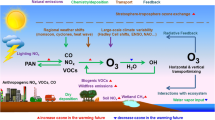Summary
Using climatological observations from a site near the Okstindan icecap, calculations of the hourly rates of atmospheric cooling experienced by the human body have been made based on a physiological heat balance model. Instantaneous cooling rates were also examined based on the highest wind speed within each hour and related to the mean hourly rates. The weather was variable during the experiment so that comparisons could be made of the cooling rates during anticyclonic and cyclonic conditions. Estimates of the altitudinal increase in cooling rate were obtained based on sample transects of temperature and wind speed.
Zusammenfassung
Basierend auf ein physiologisches Wärmebilanz-Modell wurden mit Verwendung klimatologischer Beobachtungsgrößen von einem nahe dem Okstindan-Eiskap gelegenen Orte stündliche Werte der vom menschlichen Körper betroffenen atmosphärischen Abkühlung berechnet. Es wurden auch die auf der größten Windgeschwindigkeit innerhalb einer Stunde basierenden momentanen Abkühlungsgrößen bestimmt und zu den mittleren Stundenwerten in Beziehung gebracht. In der Versuchszeit war das Wetter so veränderlich, daß Vergleiche der Abkühlungsgrößen bei antizyklonalen Verhältnissen mit zyklonalen Verhältnissen angestellt werden konnten. Bestimmungen der Zunahme der Abkühlungsgröße mit der Höhe wurden aufgrund von Querschnittbeispielen von Temperatur und Windgeschwindigkeit erhalten.
Similar content being viewed by others
References
Falkowski, S. J., Hastings, A. D.: Wind Chill in the Northern Hemisphere. Quartermaster Res. and Eng. Command, U.S. Army. Env. Protection Res. Div. Technical Rep. EP. 82, 1958.
Court, A.: Wind Chill. Bull. Amer. Met. Soc.29, 487–493 (1948).
Hare, F. K., Thomas, M. K.: Climate Canada. Toronto: Wiley and Sons Inc. 1974.
Steadman, R. G.: Indices of Wind Chill of Clothed Persons. J. Appl. Met.10, 674–683 (1971).
Smithson, P. A., Baldwin, H.: The Cooling Power of Wind and Its Influence on Human Comfort in Upland Areas of Britain. Arch. Met. Geoph. Biokl., Ser. B27, 361–380 (1974).
Piggot, M. R.: The Feeling of Dampness at Low Temperatures. Int. J. Biomet.13, 81–86 (1969).
Thompson, R. D., Bradnam, H.: Radiation Balance and Heat Transfer Studies at Okstindsjøen, Nordland, Norway. Geogr. Ann.64A, 1–13 (1982).
Meteorological Office: Meteorological Glossary, H.M.S.O. London 1963.
von Hann, J.: Handbook of Climatology Pt. I. General Climatology. London: Macmillan 1903.
Schumacherr, C.: Der Wind in der freien Atmosphäre und auf Santis, Zugspitze und Sonnblick. Beitr. Phys. frei. Atmos.11, 20–42 (1923).
Author information
Authors and Affiliations
Additional information
Okstindan Research Project Report No. 43.
With 5 Figures
Rights and permissions
About this article
Cite this article
Smithson, P.A. Atmospheric cooling power in Arctic Norway. Arch. Met. Geoph. Biocl., Ser. B 33, 373–386 (1984). https://doi.org/10.1007/BF02274003
Received:
Issue Date:
DOI: https://doi.org/10.1007/BF02274003




